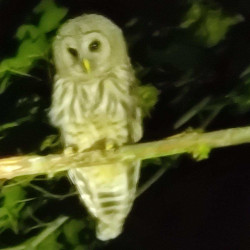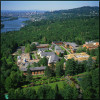Our Natural Neighbors: The Owls
Welcome Back! For our final article of this series, I want to introduce you to one of our neighbors that can be extra elusive, particularly when noise is present, the Owl. Several species of owl call the trees in and around Lewis & Clark, home. The two that have been spotted by officers so far are the Barred Owl (pictured) and the Northern Pygmy Owl. These two types of owl are easily distinguishable from each other as the Barred Owl is much larger than the Northern Pygmy Owl, and it’s gray coloration is a stark contrast to the Pygmy’s brown.

Credit: Campus Safety Officer Aiden NivenThis particular Barred Owl is Scanlan (if you get this reference, I’d love to hear about it). They have most often been spotted behind Copeland. It is believed they like to hunt rodents that come to scavenge in the dumpsters. Pretty easy pickings; however, Scanlan was also witnessed along North Drive, by Griswold Stadium, sharing a meal with Shakespeare (The Bard), another Barred Owl.
The Northern Pygmy Owl (not pictured, yet) has been seen on Graduate Campus, perched on the railing on the East Side of South Chapel. As owls are symbols of wisdom, and this particular owl selected to attend a graduate program, they have been named “Eliza Doolittle,” whose name our theatre friends may recognize from George Bernard Shaw’s play “Pygmalion” or its musical rendition known as “My Fair Lady” (give me a break, I wanted to play on “pyg” not “pig”).
Other owls native to the area, but have not been witnessed on campus yet, are Barn Owls, Great Horned Owls, and Spotted Owls (extremely rare). Oregon is actually home to 15 species of owls, but only a handful live in habitats and elevations that match our campus’ surroundings.
Owls are particularly sensitive to noise and light. Their concave facial structure operates similar to a satellite dish, and directs sound to their ears (located on their face) and light to their eyes, allowing them to have superb night vision and to triangulate the path of their scurrying prey as they hunt. Noise pollution, such as loud music or tromping through the woods at night, interferes with their ability to hunt and is additionally bothersome to their sensitive ears. Bright lights, such as flash lights, should never be shown directly at the owls. To get a photo like the one above, shine the flashlight off to the side, capturing the owl in the much dimmer, outer ring of the flashlight beam.
Given that the owls hunt primarily rodents, consider this when disposing of your trash. Anything a rat, mouse, or squirrel might mistake as food laying around, could not only poison them, but also end up in one of these owls’ stomachs. So please use the trash and recycling bins to dispose of your waste. If the bin is full, please find a different bin for your trash.
If you’d like to learn more about owls and other birds of prey on and around the campus and the City of Portland, visit the Audubon Society of Portland located at the top of Forest Park. You can drive there, or my personal favorite is to hike up to it through the trails, starting at Lower McClay Park. Here you will often be able to see birds they are rehabilitating to either release back into the wild, or if they cannot get them healthy enough for re-release, then they will train them with handlers so they can be used in demonstrations for visitors.
Once again, respecting the campus is respecting the natural world that surrounds it as well.
More Campus Safety Stories
Campus Safety is located in Campus Safety on the Undergraduate Campus.
MSC: 107
email safety@lclark.edu
voice 503-768-7855
fax 503-768-7195
Emergency 503-768-7777
Alternate Phone 503-593-5457
Director Jay Weitman
Campus Safety
Lewis & Clark
615 S. Palatine Hill Road MSC 107
Portland OR 97219

